Content marketing is becoming ever more popular.
More and more businesses are started blogs and publishing content.
They’re curating posts on social media. They’re running paid ads to drive traffic to their latest articles.
And they’re following the advice of every big name in content marketing — the blogs that coined the term and/or promoted it to the heavens.
Much of their advice is good. It helps these brands get started and understand the beneficial role content marketing can play in their business.
But as the top blogs get bigger, the same content marketing rules don’t apply to them as they do to the rest of us.
They might get 5X more shares by using visual media or including click to tweet links, but for many of us those types of tactics wouldn’t make nearly as big of an impact.
Many who engage in content marketing are still working day in and day out to build an audience like theirs. As a result, certain aspects of content marketing get preached as gospel simply because they come from authorities in the space.
From the start of my business, I have been down in the trenches experimenting. I followed the advice of content marketing authorities, and it simply didn’t apply to my fledgling blog or my client’s websites.
So I scoured the Internet to find advice that would work for the masses, and I’m happy to say I found it.
In this article, you’re going to learn 8 digital content marketing secrets that aren’t preached as gospel but can work for any business.
However, they might challenge many of the notions you’ve heard of and probably believe. So I ask you to do one thing:
Read this article with an open mind.
And I hope you will find some hidden gems to apply to your content marketing efforts.
What you will learn
Here are some of the secrets you will learn:
- Why content (by itself) is not King.
- Why on-page SEO is simpler than you think.
- The secret to tapping into bigger audiences than your own.
- 3 link building tactics that are not dead.
- The ultimate reason why content is an effective marketing asset.
- And more!
Let’s get started:
1. Content promotion is King
I’m sure you’ve heard this saying:
“Content is King!”
It relates to content as one of the most powerful forms of generating new business online.
Content is powerful. It helps you:
- Establish your business as an authority
- Enter prospect’s lives on their terms
- Open the door to start conversations with your target audience
- Spread your business around the web
But it isn’t King.
Here’s why:
Content is nothing without people reading and consuming it. Content by itself doesn’t benefit your business.
You can publish the best article on the planet, but if it just sits on your blog with no one to read it, it’s not a marketing asset.
That’s why content promotion is King.
Content promotion takes “content” and turns it into “content marketing.”
This is when you get social shares, drive traffic, and generate leads.

vs.

Without promoting your content, your blog becomes a lonely set of web pages gathering dust.
But by emailing people, running paid ads, posting in online communities and forums, and reaching out for backlinks, you start achieving all of the business objectives the big content marketing blogs talk about:
- Shares
- Traffic
- Leads
- Customers
To learn TONS different ways to promote your content and build backlinks, check out these two articles:
A 9 Step Content Marketing Plan for Any Business
10 Powerful B2B Content Marketing Strategies
After you’ve spent hours creating a piece of content, spend at least a few hours promoting it.
2. List building (not sales) should be your #1 goal
It’s easy to look at sales as your number one goal.
It affects your bottom line and is a big indicator of how well your marketing efforts are going.
But sales is only a byproduct of what comes before it, not the cause itself.
In content marketing especially, if earning more money is your primary goal, it will shine through your content and your website’s layout. Prospects will sense this, and it will detract from your content’s value.
Most prospects need multiple touchpoints with your business before they’re ready to buy. They need to come back a few times to read more of your content and check out your sales pages.
Then, once they’ve weighed their options, and they’ve built up enough trust in you, buying your products and services becomes an obvious choice.
Sounds easy, right?
Wrong.
Around 98% of visitors will leave your website without converting.
Only 2% will buy immediately (if that). So you need a way to bring people back again and again.
That’s where building an email list comes into play, and why it should be your #1 goal in content marketing.
You own the list. It’s one of the few marketing channels that you possess completely. It’s also one of the few channels that people check almost every day.
You can build relationships with these people, you can send them every piece of content you create, and you can market to them multiple times as time goes on.
So focus on list building in your digital content marketing campaigns.
Here are some great articles to get you started:
17 insanely actionable list building strategies that will generate more subscribers today
How to use a giveaway to get 2,239 email subscribers in 10 days
3. On-page SEO is simpler than you think
Many people overcomplicate on-page SEO.
They worry about exact keyword density, making sure not to link out too much, and other trivial details.
In reality, fully optimizing your content comes down to 3 key things:
- Keyword Placement
- Media (images and videos)
- Content Length
For keyword placement, you should place your exact match keyword in:
- The title
- The URL
- The meta description
- First 100-200 words of your content
- The first image’s ALT text
- 1-2 subheadings
- A few times in the body content
And keyword variations (LSI keywords) in:
- The body content
- 1-2 subheadings
Then include images and videos to supplement the learning and increase time-on-page, and link out to any relevant sources.
Finally, to maximize your on page SEO, make sure to write in-depth content, as serpIQ found that the average word count of content ranking in positions 1-3 is over 2,300 words:

(Longer content also pulls in more long-tail traffic.)
After this, your content should be fully optimized to rank for your target keyword.
4. The visitor journey leads to your website’s success
I first took my website’s visitor journey seriously after reading this case study from Matthew Woodward.
In it, he breaks down how he built a top 100 business blog in one year, from how he drove traffic, monetized it, and made a full time income.
But what stood out to me most was how he optimized everything about his site to accomplish the following goals (with the visitor journey in mind):
1. A full time subscription
2. Social shares
3. User generated content (comments/forum posts)
4. New traffic by sharing his content with others
5. New traffic from telling their friends in the pub (word of mouth)
6. Affiliate link clicks
7. Affiliate sales
For instance, he didn’t just leave his comments section alone, but when someone leaves a comment they get redirected to a page where they can follow him on social media and join his email list:

He also made his share icons as prominent as possible to maximize the amount of people who share his content:

He made sure that even after someone had subscribed, they had another opportunity to follow him on social media:

He even implemented an email autoresponder (which is over a year long, at this point in time) to continuously bring people back to his content, share it, link to it, click on affiliate links, and revitalize old posts.
Every step of the way is optimized to achieve one of his goals, and it’s all because he took the visitor journey into consideration.
Here’s a potential visitor journey for you to consider:
1. They see your content on social media, find it in a search engine, through word of mouth, a forum post, etc.
2. They read your content
3. Share it
4. Comment on it
5. Opt in to your list
6. Follow you on social media
7. Consume more of your content
8. Purchase your products/services once enough trust and desire has built up
Map out the ideal steps you want each visitor to take, then optimize your entire site to push them towards that path.
This maximizes every visitor’s value in your content marketing efforts.
1. To tap into bigger audiences, feature larger websites than your own
The hardest part about content marketing is building an audience.
Once you have an audience, the sky is the limit. You have people at your fingertips who are enthusiastic to read your content and buy your products.
You also have leverage to do joint ventures with other websites, and you’re in a position to be creative with how you market to your audience.
But getting there can be tough.
One of the fastest ways I’ve seen to build an audience is to strategically tap other websites’ audiences that are bigger than your own.
Ultimately, this involves getting them to share your content and expose you to their followers.
At first, this may seem like a daunting task. These people are busy. Why would they share my content on a whim?
Thankfully, there are two types of content that make this dead simple:
1. Expert Roundups
2. Top X Articles
In each one, you feature influencers in your niche. Then all you have to do is reach out and show them the content.
(Many will share it naturally.)
Let’s start with the first one — expert roundups.
How to create and promote an expert roundup
An expert roundup is a collection of expert opinions on a single topic.
The publisher emails as many influencers as possible and asks them a question. The answers then get combined into an article that readers will find valuable.
Here’s an example:


The first step is to choose a question. Remember, influencers are usually busy people, so come up with a question they can answer quickly, and make sure it’s something your audience would be interested in.
Then you need to gather a list of experts to feature.
To find them, first try searching for expert roundups in your niche:
- “Your niche” + “expert roundup”
- “Your niche” + “experts revel”
- “Your niche” + “interviewed experts”
Then click through to each expert’s website and find their contact info.
If you can’t find any influencers, head over to Followerwonk.
Click the “Search Bios” tab and type in a keyword related to your niche.

This will pull up a list of related Twitter profiles ordered from highest to lowest followers.

Click through to each profile, see if they have a website, and find their contact info.
Once you have a list of influencers to target, send them each an email like this:
Hey [NAME],I’m putting together a [NICHE] expert roundup for my blog, and I was wondering if you’d like to participate.
Here’s the question:
“[YOUR QUESTION]”
A 50-100 word response would be fine, but feel free to write more or less if you wish.
And of course I’ll include a link to your website and Twitter profile :)
Hope to have you on board!
Cheers,
[YOUR NAME]
As the answers roll in, combine them into an article and publish it. Then send an email to each expert to let them know that the post is live and to thank them for participating.
Many will share it automatically without you even having to ask :)
How to create and promote a top X article
Top X articles are similar to expert roundups, in that they feature a bunch of influencers in a certain niche.
Except, for these articles, you don’t need to receive any information from your experts before you feature them.
You simply include some of the top sites in your niche.
For example, here’s a top X article featuring the best personal development blogs of 2015:

All you have to do is collect the top sites in your niche, combine them into an article, and reach out to each one with an email like this:
Hey [NAME]Just wanted to give you a heads up that [SITE NAME] is featured in [ARTICLE NAME].
Here’s the link: [URL]
I’ve always loved your site and was happy to include it :)
Anyway, keep up the great work!
Cheers,
[YOUR NAME]
The top 100 personal development blogs article got a TON of shares:

(Likely because he reached out to each one to notify them.)
And the site even ranks #1 and #2 for the keyword “personal development blogs”:

Expert roundups and top X articles are excellent ways to jumpstart your audience. They put you on the radars of influential people in your niche AND their followers.
You can even maximize your return by optimizing them around a keyword.
6. Free vs. paid traffic depends on the circumstance
The argument about whether free or paid traffic is better is a common one in internet marketing circles:



Some say free traffic is better, because you’re almost guaranteed to have a positive ROI. But others turn around and say that many people who chase free traffic end up with too little to run a viable business.
Some say paid traffic is better, because you can turn it on and off whenever you want, and you can target it directly to people who are most likely to want your products and services.
But others turn around and say that this is how many people sink lots of cash into paid advertising and run into huge deficits.
In the niches I’ve worked in, I’ve always started with free traffic first. Once this base was established, I moved into paid traffic to supplement it.
But there are other circumstances where paid traffic is the best route to take. So, in reality, it depends on the niche you’re in, the budget you have, and type of site you’re running.
A solo blogger might do well starting off with free traffic, like guest blogging. But an ecommerce site might want to experiment with paid advertising to test their copy and make sure the site is ready to convert.
No matter what circumstance you’re in, you don’t truly know what will work best until you test it.
And that goes for just about anything in internet marketing.
7. These three link building tactics are NOT dead
I’m sure you’ve heard statements like these before:


“Directory submissions are dead!”

With every Google update, a link building tactic that has been used to game the search engines becomes extinct.
Why?
Because once a large amount of people get hit and the reason is identified, the big SEO news outlets feature the aftermath and people get scared away from that tactic (which is exactly what the search engines want).
I choose to view link building this way:
Any tactic has the possibility of working, because each site is unique.
Each site has a unique backlink profile, anchor text profile, on-page SEO, etc.
Spamming any one link building technique increases the likelihood of getting penalized. Not surprisingly, the sites that get penalized and make the news usually spammed the tactic.
On the other hand, strategically implementing an array of techniques will minimize that possibility.
With this in mind, I have used these three so-called “dead” link building tactics to rank mine and my client’s content.
I used blog commenting to help one website increase search traffic 1,029% in 4 months:

I used guest posting to help another website rank a piece of content and attract over 80,000 visitors to the page in 5 months:


And I used directory submissions to help that same site rank a piece of content and attract 55,000 visitors since it got published.

Each page wasn’t ranked solely with that one tactic, but it was a major part of the overall link building strategy.
These tactics aren’t dead. In fact, since many people believe they’re dead, you can use them to get a massive leg up on your competitors.
Just make sure not to spam any single link building tactic. Rather, work them into your overall SEO strategy.
8. Content is an effective marketing asset because it helps people
This is the ultimate reason why digital content marketing works, yet few people talk about it.
Content isn’t just an effective marketing asset. It improves people’s lives.
In a B2B sense, it usually helps people do their jobs better or get better business results. In a B2C sense, it’s usually a form of entertainment or helps people get more out of a product or service.
The more your content helps people, the more effective it is as a business asset.
For example, the top digital marketing bloggers get comments like these all the time:



Even though this is digital marketing, you can see the emotion these people feel after reading a piece of content they know is extremely valuable to them.
These are the people who end up sharing your content, joining your email list, and buying your products and services.
So to create more effective content and run more successful campaigns, focus on the value your content is providing to people.
This is what will ultimately lead to a powerful content marketing strategy.
To wrap it up
These digital content marketing secrets may have challenged what you previously believed about certain aspects of internet marketing.
I hope that you were able to read them with an open mind, and hopefully I convinced you to try a few that you might never have considered.
As with anything in digital marketing, you never truly know what will work for your business until you test it.
So test away, and maybe you’ll discover a few of your own secrets to share.
The success of your agency depends on its ability to produce wow factor in the content you create for your clients.
By “wow factor,” we don’t mean flowery tomes.
We’re talking about content that produces leads.
You’re not writing a best-seller, after all—you want your clients’ content to bring in business. Read the rest of this entry »
Branded content marketing is becoming a powerful top-of-the-funnel strategy for many businesses.
It keeps them at the forefront of consumer’s minds, and it helps to build a positive brand image.
This form of content marketing also takes advantage of social media to spread brand awareness.
What Is Branded Content Marketing?
You might be asking yourself:
“What is branded content marketing?”
A Forrester report defines “branded content” as:
“Content that is developed or curated by a brand to provide added consumer value such as entertainment or education. It is designed to build brand consideration and affinity, not sell a product or service.”
Branded content marketing primarily provides entertainment or educational value. It connects that value to the brand’s overall image.
Here are a few types:
- Creative videos
- Social media engagement campaigns
- Consumer input into product decisions
- Educational ebooks and content
- Participation-based content
- Responding to what consumers are discussing in real time with content that’s related to those conversations
We’ll be discussing each of these in full.
Forrester has identified four ways branded content can help build a brand’s image:
- Educate and inform to build a trusted brand.
- Create topical, shareable content to build a remarkable brand.
- Develop stand-out content to build an unmistakable brand.
- Become part of your customers’ daily routine to build an essential brand.
(Source: Forbes)
This type of content marketing builds trust and helps a brand stand out amongst its competitors. It also tends to get shared and talked about on social media more than other forms of digital marketing.
The selling is kept to a minimum. That’s what makes branded content a smart top-of-the-funnel strategy.
Branded content marketing help you build a trusted and remarkable brand
Click to tweet
The Difference Between Regular Content Marketing and Branded Content
According to Our Social Times, regular content marketing campaigns focus more on the product or service. The content is usually more rational and informative.
It also takes place further down the buying cycle. Unlike branded content, ROI is more about lead generation and sales than building a positive image of the brand.
Branded content marketing campaigns are often focused on promoting entertainment-type content, such as creative video advertising.
The aim is to resonate with the consumer on an emotional level, rather than focusing on the actual product and unique selling propositions.
3 Successful Branded Content Marketing Examples
These three companies used branded content to effectively spread awareness, educate and help their consumers, and cultivate a positive brand image:
General Electric’s — “GE Reports”
GE Reports is General Electric’s digital magazine. Launched in 2008, it covers research, strategy, innovation, and opinions on a range of topics:
- Business
- Digital transformation
- The Internet
- GE’s business results
- Manufacturing
- Public policy
- The global economy

Tomas Kellner, a former Forbes journalist with a background in engineering, is the managing editor of GE Reports. According to an interview by NewsCred, Tomas and his team aim to publish content that gets noticed by the press. This earns additional coverage for GE.
They have also used the GE Reports platform to launch more than a few pieces of branded content.
In one video, they had Matthew Dear, a prominent DJ, record sounds of GE’s jet engines. He then mixed and looped these sounds into a techno beat.
It got over 400,000 views on Youtube and allowed GE to tap into a new audience they would have otherwise missed: Fans of electronic dance music (EDM) and Matthew Dear.
Brand value for GE: GE Reports helps them get free coverage on social media and news sites (as opposed to sending out paid press releases) and they can be more creative with the audiences they tap into.
Australian Metro’s — “Dumb Ways to Die”
Despite its whacky name, this campaign actually lead to less train-related accidents in Melbourne.
Public service announcements are notoriously boring. They’re like your parents scolding you for not doing the dishes or cleaning your room.
They tend to get tuned out.
Metro took a different approach that was bound to get attention. They created a short, animated video called “Dumb Ways to Die.”
The cute little characters begin by dying in silly and outrageous ways, but by the end of the video, they’re all dying in the train-related accidents that are actually happening in real life.
Then, finally, it ends with Metro’s core message. Take a look:
[youtube http://www.youtube.com/watch?v=IJNR2EpS0jw?rel=0&controls=0&showinfo=0&w=620&h=349]
Because of this campaign, there was 10% reduction in near misses and accidents, and the campaign website received over 1 million pledges to be safe around trains.
They also created an app that got downloaded over 35 million times.
Try getting those results from a regular public service announcement.
Brand value for Metro: Not only did they accomplish their goal of reduced accidents, but the video showed that Metro cares about their passengers’ welfare. This spread a very positive brand image.
Red Bull and The Stratos Jump
The Stratos Jump: A viral internet sensation sponsored by none other than adrenalin junkie energy drink, Red Bull.
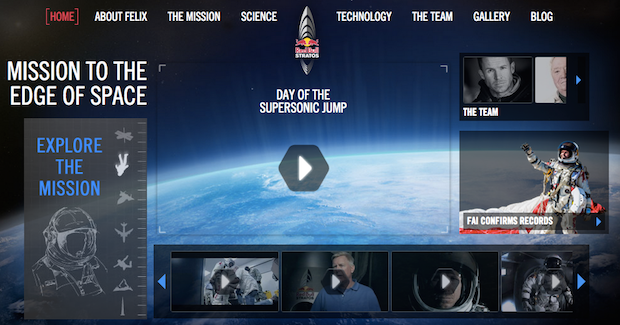
On October 14, 2012, Felix Baumgartner executed the supersonic freefall from outer space.
He became the fastest man ever in freefall, by reaching a preliminary speed of Mach 1.24 (833.9 mph). In other words, he broke the speed of sound.
“When you are standing on top of the world, you don’t think of records anymore; all you think is that you want to come back alive.” — Felix Baumgartner
Nowhere on the official website do they discuss that Red Bull’s mission was to spread brand awareness and their image as a high-octane energy drink.
In fact, Red Bull Stratos’ stated mission is “to transcend human limits.”
Yet they were able to transcend human limits and help their brand go viral. I’m sure Red Bull’s competitors were watching and weeping.
Check out the jump for yourself, and don’t forget to take note of the branding:
[youtube http://www.youtube.com/watch?v=FHtvDA0W34I?rel=0&controls=0&showinfo=0&w=620&h=349]
Red Bull sales in the U.S. rose 7% to $1.6 billion in the six months after The Stratos Jump.
According to a private company, Red Bull sold 5.2 billion cans worldwide in 2012, a 13% increase over the year prior.
Branded content marketing gave Red Bull wings.
Brand value for Red Bull: The Stratos Jump reinforced Red Bull’s image as an energy drink that supports action, adventure, and risk taking — the same core values their target audience exemplifies.
Learn how Red Bull used branded content to sell 5.2 billion cans in 2012
Click to tweet
The Move From Traditional Advertising to Branded Content (And Content Marketing in General)
There’s a reason why older advertising techniques, like billboards, newspapers, and radio, are now dubbed “traditional” advertising.
These techniques are being supplemented by, and in some cases, completely replaced, by newer forms of marketing.
These forms achieve the same objectives as traditional advertising, but in ways that consumers actually want to be advertised and marketed to.
Consumers want to become educated buyers who glean as much information as they can before making a buying decision. They want to do their research and have conversations using this knowledge.
Branded content (and content marketing in general) facilitates these conversations. They become inroads into consumer’s lives where brands can engage them on the same level.
They’re not talking to consumers, like traditional advertising, but rather with consumers.
Sharing, tweeting, liking, and commenting all become digital word-of-mouth that fits in seamlessly with the social networking consumers are already doing.
Not to mention, word-of-mouth is still the #1 most trusted form of advertising and promotion:
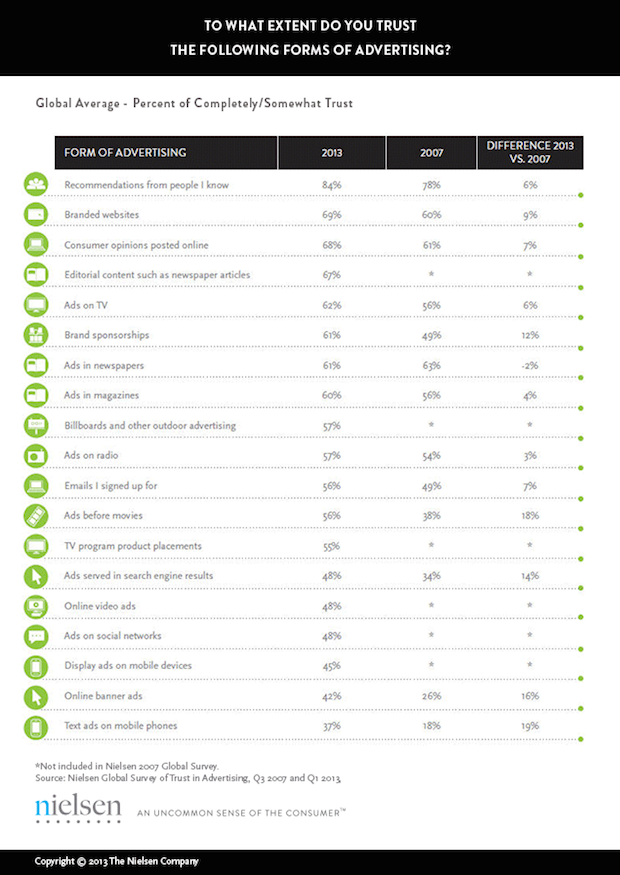

Not coincidentally, word-of-mouth is followed closely by branded websites, consumer opinions posted online, editorial content, and brand sponsorships.
The move from traditional advertising to branded content marketing can be seen both theoretically and in the data.
How Consumers Want to be Sold to These Days
Consumers hold the power.
Whereas brands and salespeople used to hold the knowledge about their products and services, consumers now have access to this information before making a purchase or engaging with a brand.
They’re smarter, and they want brands to acknowledge that and market to them in ways that facilitate this new buying process.
Here are four ways consumers want to be sold to these days:
- Storytelling
- Useful (free) information
- Getting involved in the marketing and promotion
- Feeling as though brands have insight into their lives
Let’s break down each of these branded content marketing methods:
1. Storytelling
People love stories.
Stories move you, consume you, and engulf you in new worlds and insights. And guess what? Every brand has a story, and every consumer engaged with that brand has a story.
These are the stories that help your brand resonate in consumer’s hearts and minds.
Lyft does a great job of this. Their #WhyILyft campaign showcases why drivers and passengers choose Lyft and how the service has affected their lives.
Here’s an example:
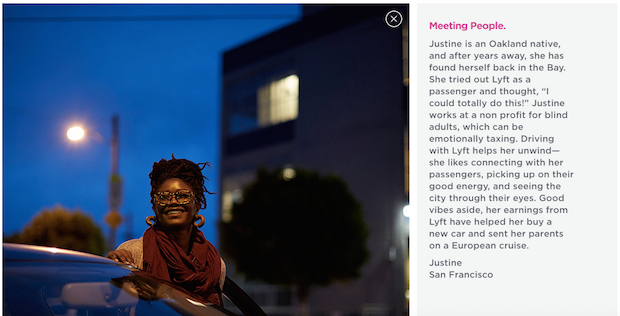
This tiny blurb communicates that Lyft is more than a job for Justine. She uses it to unwind from stressful days, connect with people, and see the city through their eyes.
This form of branded content reaches people on a higher level, by capturing the deeper emotions behind the product or service.
Lyft has a full page of these stories from their campaign:
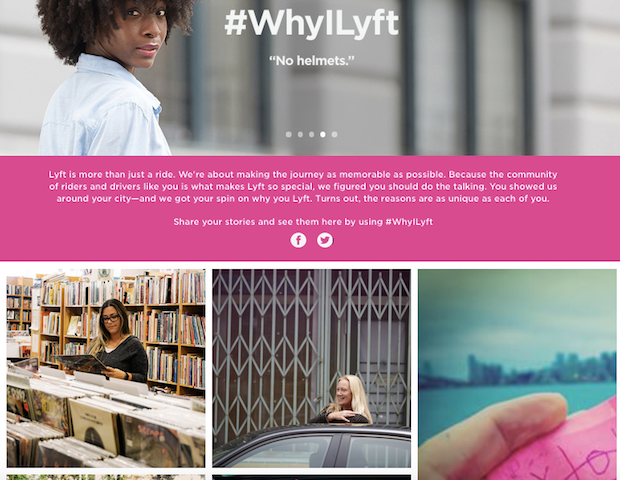
2. Useful (Free) Information
Consumers have the power to research anything they want about a product or service,
But it can be even more powerful if that learning material is provided by the same business that’s selling the product or service.
Here’s an example:
Copyblogger is a content marketing blog that sells a number of digital products. Their digital products help people achieve certain goals online:
- More sales
- More traffic
- Increased search engine rankings
- High performing websites
They’ve paired their products with 16 in-depth resources that give people the background they need to use them effectively (and a free 20-part course in internet marketing):
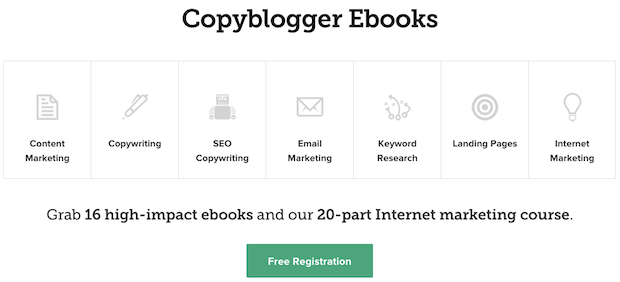
Each ebook breaks down the subject so readers can fully understand it. Then they finish with a branded pitch that leads naturally into one of their products:
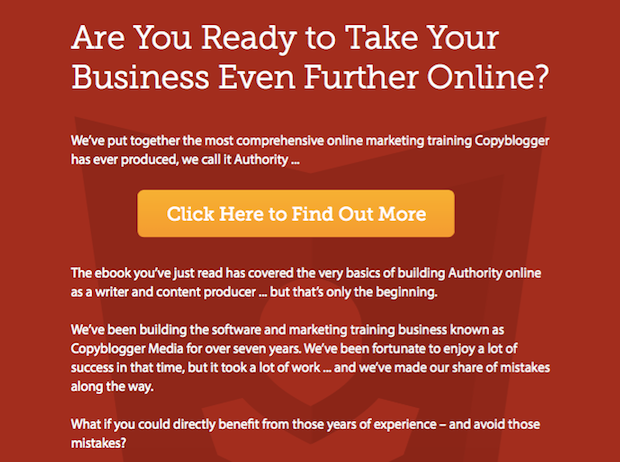
This useful free information gives potential customers the foundation they need to want that product or service and the skills to use it effectively.
Prospects see Copyblogger as a teacher and mentor, rather than a retailer.
3. Getting Involved in the Marketing and Promotion
Social media is a powerful platform to build engagement with your brand.
In many cases, you can build this engagement and achieve your business goals at the same time. Two entities have done this beautifully:
- The ALS (Amyotrophic Lateral Sclerosis) Association
- Starbucks
Do you remember the ALS Ice Bucket Challenge? It took social media by storm.
Everyone from average Joe’s to famous celebrities were pouring buckets of ice on their head, stating a donation to the ALS foundation, and nominating someone else to do the same thing.
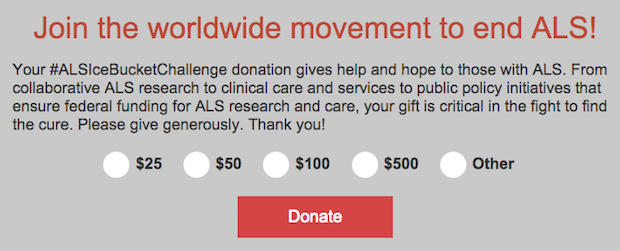
Talk about viral marketing!
The campaign has raised $77 million in research funds and $23 million in patient services, among other areas:

The Ice Bucket Challenge did a number things right:
- They got people involved. They riled up support for a cause and gave people an exciting way to participate.
- They introduced a viral component. They didn’t just say, “Use the #ALSIceBucketChallenge hashtag and share it with your friends.” They said, “Nominate someone else and get them involved!”
- They took advantage of influencers. In society, famous people are the influencers. Once these people began accepting the challenge, the campaign really took off.
People felt good about supporting the organization. They got involved and had a part in the impact it made. That was the key component that lead to its success.
Starbucks has done something similar with their Frappuccino Flav-Off campaign.
They took votes from fans and launched six new Frappuccino flavors:
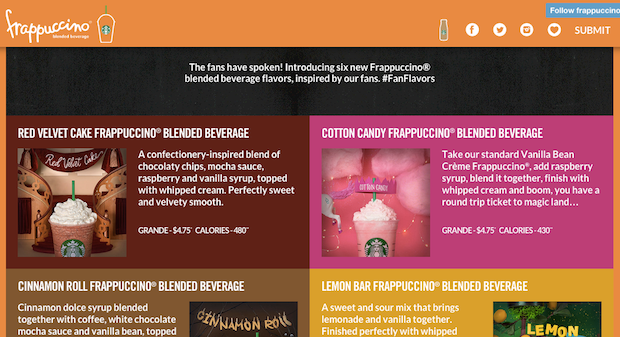
Using #FanFlavors, they were able to spread the vote to as many people as possible.
When these customers enter a Starbucks, they get excited to pick one of the new flavors, because they took part in that launch.
4. Feeling As Though Brands Have Insight Into Their Lives
When someone “gets” you, that’s a strong connection.
Brands attempt to establish this connection all the time by portraying real life situations in TV commercials and other ads.
Why?
Because consumers want to feel like brands “get” them — that they understand them.
How Your Brand Can Use Branded Content Marketing
You’ve seen how other brands have done it. Let’s talk about your business can incorporate branded content.
Here are three of the most powerful tactics:
- Run campaigns that get customers more involved in your products.
- Invite your audience into the content creation process, through participation-based content.
- Listen and respond to what consumers are discussing on social media in real time and create content to address those discussions.
1. Run Campaigns That Get Customers Involved in Your Products
You don’t have to ask people to pour ice on their heads, but you can use a similar process to the Ice Bucket Challenge and Frappuccino Flav-Off campaigns.
First, decide how you want to get your audience involved:
- Do you want them to vote on a new product?
- Do you want their help creating a new product?
- Do you want their help Improving existing products?
- Would you like them to buy a certain product so you can donate a portion of sales to charity or medical research?
Be creative, but make your campaign the center of focus, with your product as the vehicle.
Then determine a hashtag to go with it. Almost all successful branded content marketing campaigns use hashtags.
They help your campaign stand out in the clutter of social media, and it acts as branding each time someone participates.
After you’ve chosen a hashtag, create official rules/guidelines and put them on your website.

Then promote the campaign like crazy:
- Announce it to your email list and on all of your social media accounts.
- Run paid advertising campaigns using Facebook, Twitter, LinkedIn, etc. Choose the networks that match up best for your audience.
- Use different forms of media to promote the campaign, including videos, articles, testimonials, stories, and infographics.
2. Invite Your Audience Into the Content Creation Process
To do this one, first choose a form of content for people to participate in:
- Article
- Video
- Infographic
- Song
For articles, you might have seen expert roundups before. If not, expert round ups are articles that collect opinions from influencers on one topic.
Usually, the publisher emails as many influencers as possible and asks them to answer a specific question.
Here’s an example:
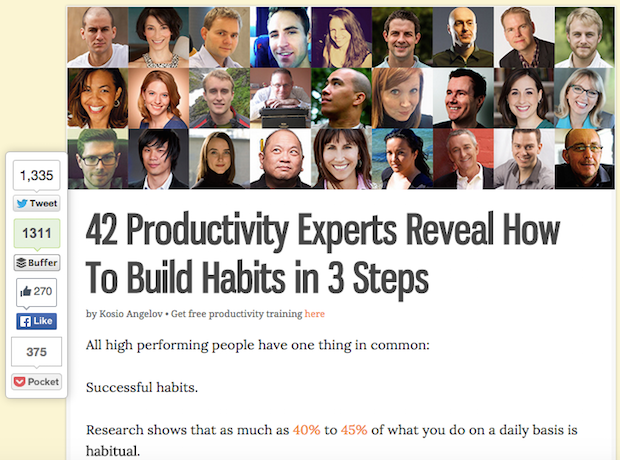
Once the article is published, the publisher reaches out to each expert and lets them know the post is live and that it would be awesome if they shared it.
You can do the same thing with your audience.
Just like any campaign, create rules/guidelines on your site, a hashtag, and promote it like crazy.
But this time, send people to a page where they’re asked to submit their opinion on one topic. Then ask for their contact info if they want to be notified when the post is live.
Collect all of those opinions into one article, reach out to each person who participated, and ask them to share it.
You can follow a similar process with videos, infographics (like promoting a survey), songs — whichever form works best for your audience.
3. Listen to What Consumers Are Discussing on Social Media and Create Content to Address Those Discussions
One of the most powerful notions in content marketing is to create content that is timely.
This means the topic is relevant to your audience, and you promote it as soon as possible after that relevance exists.
This can mean responding to current events, social change, changes in consumer behavior, etc.
One way to do this is to monitor what consumers are discussing on social media, create branded content that relates to those discussions, and promote it to those people.
The best tool I’ve seen for social monitoring is BuzzBundle.
BuzzBundle is a piece of social media management software that allows you to monitor discussions on multiple social networks. You can then respond to those discussions in real time — all from one convenient user interface.
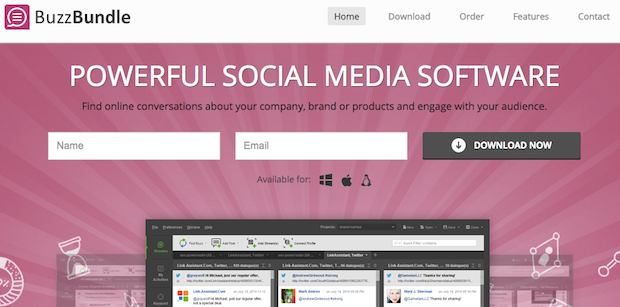
First, download the free trial of BuzzBundle. Then open the program.
It will ask you to create a few personas. Each persona links up to a social media account of your choice.
Create a persona for each network you’d like to participate on:
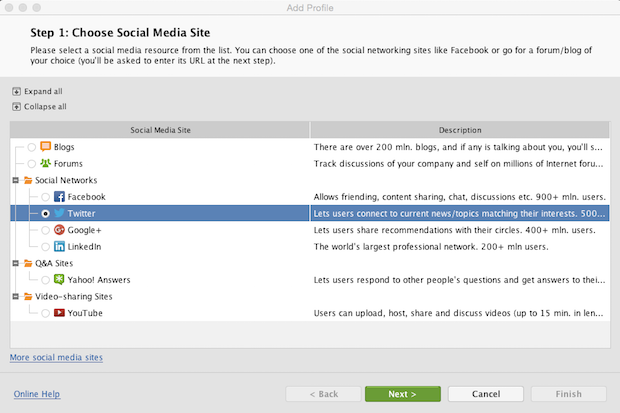
Then head into the Keyword Groups tab on the left and click Add:
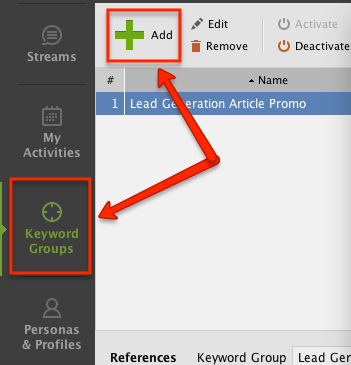
Type in keywords related to topics your audience might be discussing. BuzzBundle will use these keywords to scrape social media networks and find where these discussions are happening.
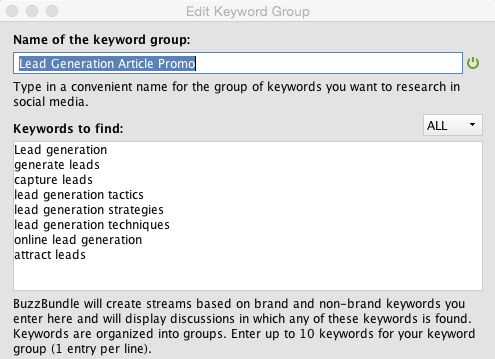
Once you’ve created a keyword group, click the Streams Tab and Find Buzz:

BuzzBundle will start scraping social media for those conversations. (This could take a few minutes.)
When it’s done, the program will have pulled up all of the conversations that include your keywords. You can now go through these conversations and respond directly from BuzzBundle.
Next, create content that addresses these discussions. This could be an article that helps your audience achieve a certain goal, a branded video, or an infographic.
When you’ve published that piece of content, head back into BuzzBundle and promote it.
Using Branded Content to Stay Ahead of Your Competitors
Just to reiterate, here are the goals of branded content marketing once more:
- Provide educational or entertainment value
- Build trust in your brand
- Stand out in consumer’s minds
- Become a part of your customer’s daily routine
- Resonate with the consumer on an emotional level
Your aim is to spread awareness and a positive brand image. By involving your customers and engaging them on an emotional level, you become the brand they trust and connect with.
When deciding whether or not to choose you or your competitors (that aren’t as involved in their lives) you will become a more obvious choice for them.
People buy from brands they trust. They buy from brands they’re accustomed to buying from. And they buy from brands they’re exposed to more often.
This is exactly what branded content marketing does.
It keeps you at the forefront of their thoughts when considering which products to buy, and helps your business become one of their first choices when they have a need to fulfill.
Create a plan to incorporate branded content into your strategy, and let it rip.
It’s no secret that mobile is changing the way everyone does business online.
Think about how often you use your phone to browse websites, access social media, fill in forms, and conduct searches. Now translate that usage to every smartphone user.
Salesforce states that 83% of mobile internet users expect a seamless experience across devices. Users expect the usability of their desktops to translate to their mobile devices.
As with any major wave in business, marketers have to adjust to consumers, not the other way around. This is especially so in content marketing, as you’re trying to engage, build trust, and make sales – all at the same time.
83% of mobile internet users expect a seamless experience across devices
Click to tweet
I’ve compiled 9 mobile content marketing trends that could have profound effects on your business in the future.
These trends are only going to continue upwards as time goes on. Marketers should be aware of them and adapt to fit consumer’s lives.
Here are 9 of the most powerful mobile content marketing trends we’re facing:
1. Increase in overall mobile internet usage
Check out these startling facts about internet/mobile device usage from December 2010 to December 2014:
- 21 percent of Millennials no longer use their desktops to go online.
- More than 75 percent of all Americans who use the Internet (age 18+) now access digital content on both desktop and mobile devices, which is an increase from 68 percent a year ago.
- The 55-years-and-older consumer segment is actually the fastest growing faction of mobile users.
- Smartphone usage is up 394 percent, and tablet usage is up 1,721 percent.

Source: comScore
More people than ever are using their phones/tablets to browse the Internet. What does this mean for your content marketing efforts?
With everything you publish, you need to consider how it’s going to look on mobile and if it will be effective. Follow these guidelines:
- Paragraphs in your blog posts should be no more than 3-4 sentences long.
- Your images should fit the screen.
- Text should be big enough to read on small devices, without straining the reader’s eyes.
- Your website should be easy to navigate.
- Your forms should be user-friendly and functional.
- Videos should load the same as they do on desktop.
- Pop-ups should fit the screen.
- Users should be able to get the information they need and not be hindered because they’re using a mobile device.
These are just some of the mobile content marketing guidelines you need to consider as usage increases in the future.
2. Google is favoring mobile-friendly pages
In an official Webmaster Central blog post, Google announced that starting April 21, 2015 they would start favoring mobile-friendly pages in search results.
“Starting April 21, we will be expanding our use of mobile-friendliness as a ranking signal. This change will affect mobile searches in all languages worldwide and will have a significant impact in our search results. Consequently, users will find it easier to get relevant, high quality search results that are optimized for their devices.” – Google Webmaster Central Blog
This should have came as no surprise. Google is always trying to provide the most relevant, user-friendly results possible. Mobile devices are no exception.
According to a Searchmetrics study, some of the top sites have already taken hits in their mobile SEO visibility:
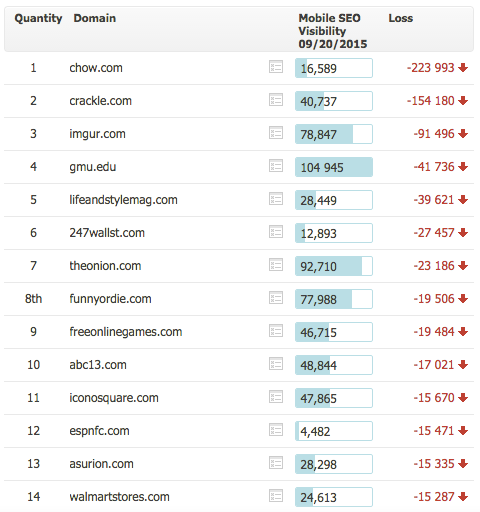
What does this mean for your website? Well, if you saw a hit in your mobile search engine traffic, this algorithm change might be the culprit.
“I would not be surprised if large sites can take up to a month to be displayed as fully mobile friendly. So make sure your most important pages are indexed as mobile friendly sooner than later.” – Barry Schwartz, Search Engine Land
To see if your site fits the description, use Google’s Mobile-Friendly Tester. If it doesn’t, follow this guide to make your website mobile-friendly or this plugin if you’re using WordPress.
3. The rise of SMS marketing
SMS marketing involves consumers opting in to receive texts from a company. These texts can contain promotions, deals, loyalty rewards, alerts, and other marketing materials.
For example, if you opt in to one of Amazon’s text message updates, you can receive a text anytime there’s an upcoming deal available for your Kindle.
According to Salesforce’s 2014 mobile behavior report, 91% of consumers who opted in to a company’s SMS texting found it useful.
And EZ Texting, an SMS marketing service, states that over 50,000 clients use their service in businesses such as:
- Bars and nightclubs
- Restaurants
- Real estate
- Retail
- Small businesses
These consumers want to be marketed to in one of their most coveted inboxes – their text messages. That’s a big discovery for marketers.
The key, like with any marketing channel, will be balancing value provided with value extracted. Abusing someone’s text message inbox even one time can get that right retracted.
4. Mobile content marketing lead generation: considerations and conversion rates
49% of B2B marketers are heavily engaged in mobile marketing for generating leads. (Source: MarketingProfs)
As more of your traffic transitions to mobile devices, the way you optimize lead generation will change as well.
Here are a few common ways to generate leads:
- Sidebar forms
- Pop-up forms
- Landing pages
- Feature boxes
- Pop-up lightboxes
- End-of-post opt-ins
- In-text forms
If your site is mobile-friendly, your sidebar form is probably one of the last items your visitors scroll to. Instead of being at the top of the page, it’s now below the body content.
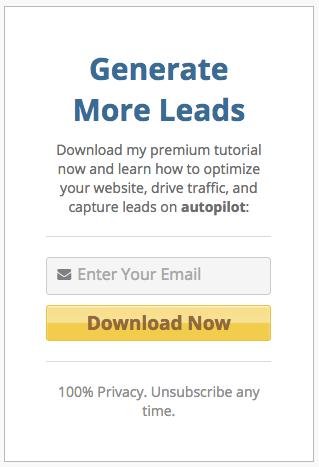
This means you should consider installing other opt-ins as well, like pop-up forms or feature boxes, to engage visitors immediately.
Estimated conversion rate: 0.3-1%
Your pop-up form must be formatted for mobile. Many pop-forms tend to lose their formatting, making it difficult or impossible to submit contact information (even if the visitor wants to). Not optimizing these for mobile could leave leads on the table.
The following is an example of a poorly formatted pop-up. It’s not an opt-in form, but its design causes a lower user experience:
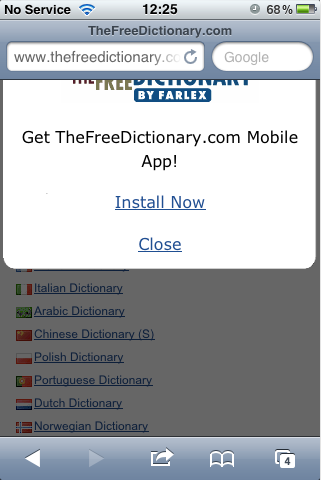
The next form is formatted well. It allows а user to scroll up and down to read the full text, and the opt-in field and button are user friendly:
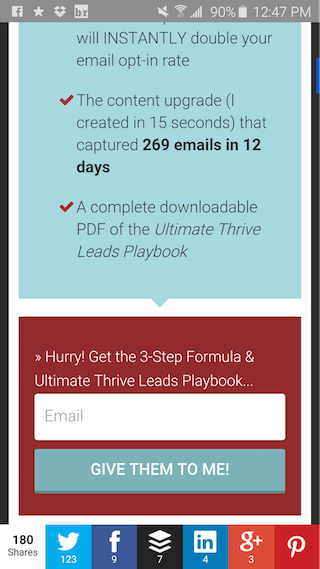
Estimated conversion rate: 2-5%
If your site is mobile-friendly, your landing pages are most likely formatted for mobile. But you should make sure they’re easy to navigate to on any device.
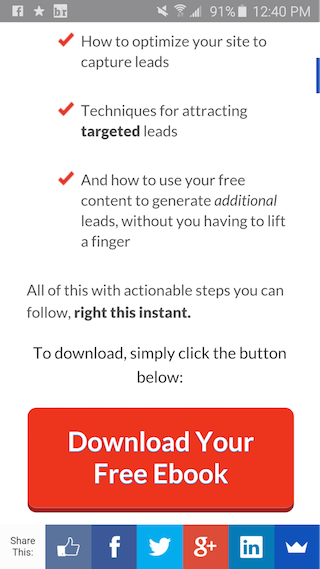
Estimated conversion rate: 5-25%
A feature box is an opt-in at the top of the page. It comes before the content and is usually the first opt-in a visitor sees.
Because of this, feature boxes can be effective for converting mobile visitors. Here’s an example:

Estimated conversion rate: 5-7%
Pop-up lightboxes should be formatted the same as your regular pop-up. Make sure they can be filled in and submitted on any device.

Estimated conversion rate: 2-10%
Opt-ins at the end of your posts and in-text should also be formatted for mobile.
Estimated conversion rate: .4-1.2%
If you can set up all of your opt-ins to be user-friendly on mobile devices, you’re ready to get favorable conversion rates, as a report from Mobile Marketer shows.
5. Converting sales on mobile
Check out these statistics regarding smartphone purchases, from an Interactive Advertising Bureau’s study:
- Men (56%) are more likely than women (45%) to make purchases via smartphone.
- 76 percent of males ages 18-34 make a smartphone purchase in a typical month. 59 percent of females in this age group make the same type of purchase.
- 39 percent of 18 to 34-year old smartphone users said they spend at least $51 or more making purchases via smartphone in an average month. That compares to 27 percent of survey participants overall.
- Smartphones ranked second only to computers among CE devices used for shopping.
- 40 percent of smartphone owners said they use their device to research products.
Source: TeleCompetitor
This means that most young adult smartphone users, regardless of gender, make at least one purchase from their phone each month, and 39 percent of them spend at least $51.
Men (56%) are more likely than women (45%) to make purchases via smartphone
Click to tweet
Consumers are willing to spend money using their mobile devices. As this trend continues, digital marketers will need to ensure their landing pages are mobile-friendly, that the page conveys trust in the payment system, and that the payment process is as seamless as possible.
6. Mobile Apps supplementing or replacing websites
Apps can turn the most cumbersome website into a clean, user-friendly interface.
Many banks have gone this route, as their websites can be hard to navigate on mobile devices.
Apps can supplement websites or completely replace them in terms of functionality and usability.
Marketo notes 3 mobile app trends for marketers to take advantage of in 2015 and beyond:
1. Mobile apps as landing pages
Just like landing pages are a single page with a dedicated goal, companies will start creating niche apps (with push notifications) to act as mobile landing pages.
2. Small and medium-sized businesses will use mobile apps for lead generation and brand awareness
SMBs will follow the lead of larger companies in creating apps for their businesses. However, small and medium-sized businesses will have to market their apps harder to get downloads.
3. Established companies will put mobile apps at the core of their product or service
More companies will launch new products and services where the app is the product — much like Uber and Snapchat.
Each of these trends can be used by marketers to reach additional users more efficiently.
7. Increased Mobile Ad spend
Mobile is growing faster than all other digital advertising formats in the US, as advertisers begin allocating dollars to catch the eyes of a growing class of “mobile-first” users. – Mark Hoelzel, Business Insider
With increased mobile usage comes increased spending on ads targeting mobile devices.
eMarketer found that in 2016, global mobile advertising spend will surpass $100 billion and account for more than 50% of all digital ad expenditure. This will be the first time this has ever happened.
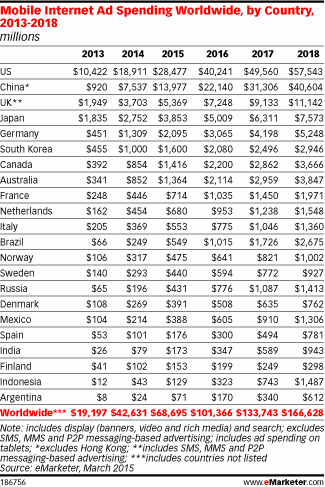
Companies can expect to spend more and more on mobile ads, shifting their budgets in parallel with how mobile usage is growing.
8. Increased focus on user experience in email marketing
Email is still a top channel for promoting products and services. According to these studies…
- 91% of consumers reported checking their email at least once a day. (ExactTarget)
- Email marketing was ranked as the best channel in terms of return on investment, with 68% of companies rating the channel as ‘good’ or ‘excellent’ (Econsultancy)
And according to EmailMonday, mobile email opens have grown 180% in three years, from 15% in 2011 to 42% in 2014 (Campaign Monitor “Email interaction across mobile and desktop”).
With more people accessing email on their mobile devices than ever, and the consistent effectiveness of email marketing, marketers need to make sure their emails are user-friendly on mobile devices.
Many email marketing services offer a plain text option (as compared to HTML) so marketers can choose to make sure their emails can be read adequately on any device.
As more and more people open emails on their mobile devices, mobile formatting will become more crucial to maintaining your ROI from email marketing.
9. Optimizing your social media posts for mobile
The #1 category in terms of overall digital engagement, accounting for 20% of total digital time spent, social networking now generates more than 70% of its activity on mobile. When considering the category’s contribution to total digital ad spending, its rapid shift to mobile marks an important sign of the times for the internet economy. (Source: comScore)
70% of social networking is now done on mobile devices. That’s the same percentage as entertainment/music:
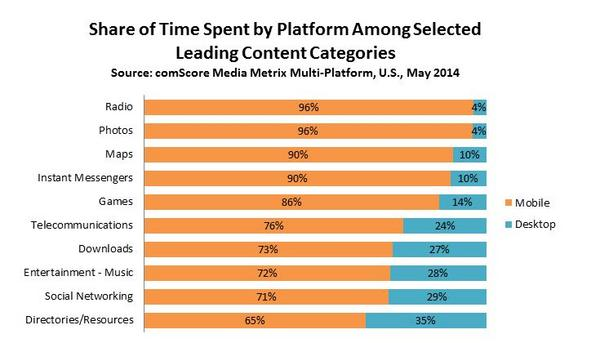
Needless to say, for your posts to be engaged with, they should be optimized for mobile viewing:
- Your images should be the right size for each specific network.
- Your calls-to-action should fit in the required space without an ellipses (…).
- Any text in the image should be big enough to read.
- You should expect users to click through on their mobile devices, meaning your website should be optimized to greet them there.
To wrap it up
These trends in mobile content marketing affect the way users engage with your business and how you market to them.
It’s important for marketers to understand these trends, adjust their businesses to them, and eventually take advantage of them.
That’s how you will continue to grow your business as mobile becomes a bigger and bigger part of consumer’s lives.